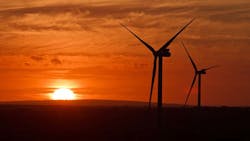AWEA says a Wind Rush is Underway
The American Wind Energy Association (AWEA), Washington, D.C., says new turbines with bigger blades are making wind an economical energy choice in more areas of the United States.
According to AWEA, advanced wind turbines are accessing faster, steadier winds at higher altitudes so they can generate more electricity, creating a modernday “wind rush” as new areas in the Great Lakes states and the Southeastern U.S. become economical sites to develop more wind energy. “Taller towers, longer blades and improved electronics to operate and maintain the turbines are all part of this revolution.” said AWEA CEO Tom Kiernan.
AWEA said modern wind turbines require a wind speed of only about 8 miles per hour (5 meters per second) to start generating utilityscale quantities of electricity. Sites with comparatively lower average wind speeds can now be considered for commercial turbines for the first time.
“The Great Lakes region is an early beneficiary of this,” said Emily Williams, deputy director of industry sata and analysis, in the AWEA release.“In states like Michigan we’re absolutely seeing a wind rush.” With continued technology advancements, states that currently have no commercial wind turbines at all, primarily in the Southeast, will see development opportunities open up in the coming years.
Highwind areas are becoming even more productive thanks to longer blades, as the average annual “capacity factor” or percentage of the maximum rated capacity that a turbine generates yearround now tops 50 percent in some cases. Some older sites are being repowered by new turbines. Others are receiving a variety of refinements to existing turbines such as blade tip extensions, vortex generators, and improved electronics, making them more productive.
These innovations have contributed to a drop in the price of windgenerated electricity. The levelized cost of wind energy (LCOE) has dropped 58 percent in just five years, according to the most recent study by Wall Street financial advisory firm Lazard. LCOE is the net cost to install and operate a turbine, divided by its expected lifetime energy output.
